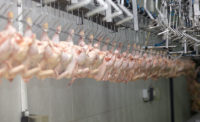Antimicrobial dips and sprays aid in food safety of suppliers’ raw product by reducing the micro load that comes from areas including the hide, intestinal tract and the environment. Hence, the application of an antimicrobial intervention can be seen as a positive step for total food safety.
“The sprays, along with being beneficial in reducing the pathogenic microorganisms, also improve the product shelf life,” says Rich Chiaramonte, directory of food safety at Stampede Meat, in Bridgeview, Ill.
Companies are developing and evaluating various blends of antimicrobial dips and sprays they hope can be even more effective as multi-hurdle interventions. For example, blends with very high and low pH solutions and also blends that have increased concentrations with a shorter application time are being developed, Chiaramonte says. Other advancements include various application methods of these chemicals and better techniques in automation used to measure and monitor these antimicrobials.
Newer applications of antimicrobial dips and sprays also are being prepared using more naturally occurring materials as well as organically approved, says Carl Zerr, director of food safety/quality assurance and regulatory affairs for Rastelli Foods Group, in Swedesboro, N.J.
“These steps are inherently important as many more families are seeking natural, organic and other safe alternatives with more assurances that the foods they use to feed families are safe,” he explains.
Rastelli Foods uses a varying hurdle technique across the broad spectrum of products manufactured in their Swedesboro facility. For example, any beef product that is not a solid-muscle steak item receives an organically approved antimicrobial intervention process to kill or otherwise eliminate the likelihood of foodborne pathogens, Zerr says.
Stampede Meat also uses a multi-hurdle intervention system, which has shown to provide a minimum of 2-log reduction in microbial counts and pathogens. “We have also seen results at 3-4-log reduction on this system during our annual validation testing,” Chiaramonte says. “Combined treatment of interventions generally have significantly higher log reductions than a single-intervention application.”
Currently, Stampede Meat is using multi-hurdle antimicrobial sprays on beef subprimals in all of its raw processing facilities. “We audit our suppliers to make sure that their HACCP (hazardous analysis and critical control points) program includes the use of validated interventions, such as organic sprays,” Chiaramonte says.
Stampede Meat’s leaders think it is very important to have a sound HACCP program to go along with its multi-hurdle interventions that are applied at its facility to control the micro load and pathogenic microorganisms of raw meat coming into the facility. “We need to protect our customers and consumers by giving them finished product that is negative for E. coli O157:H7.”
Examining new interventions
While antimicrobial dips and sprays continue to advance, challenges still exist in this area.
“Many of the current interventions, while safe, are chemical alternatives,” Rastelli Foods’ Zerr says. “These are all FDA-approved and tested intervention methods, but all the same, are chemicals used to kill bacteria. More and more work is currently being done using more naturally occurring substances to apply as mitigating steps in the prevention of illness due to pathogens. Unfortunately this all takes time.”
New methods of intervention in the world of pathogens are ever evolving as well. “We’ve seen the use of high-pressure pasteurization, organic acid sprays, naturally occurring sprays and dips, ultra-violet lighting, irradiation and other manners to preserve and make food safe,” Zerr says. Better agricultural practices along with new farming methods and processing techniques, in which no one even touches the product directly, also are helping reduce pathogens.
The ongoing use of sprays and dips will likely continue because of the ease of application, low associated costs and proven efficacy, he adds. “Research will continue to provide alternatives and new possibilities of interventions,” Zerr explains. “And as long as we are dealing with living sources of meat and other proteins, the need to intervene against known pathogens in the food chain will continue.”
In addition, these antimicrobial sprays do not sterilize raw product. “Raw meat will have a level of micro-contamination, so it is very important that cross contamination be looked at very carefully by our food safety department,” Stampede Meat’s Chiaramonte says. “In order for antimicrobial dips and sprays to get even better, more information is needed on exposure times, concentration and pH to optimize efficacy. Equally important to note: There is no one solution that will achieve customer and consumer safety. A robust system must be developed that involves multiple steps and still requires testing of finished product to achieve a fulsome approach to protecting brand value for our customers.”
Chiaramonte thinks companies seem to be coming out with better immersion dip systems and also targeted in-line sprays where the spray nozzles are designed to have a much better contact on the raw meat subprimal. Equipment technology also is evolving with improvements to the agitation system in dip tanks. Companies also are working on antimicrobial sprays to be used in processing areas such as the floors, equipment, etc., for the purpose of preventing cross contamination.
“Stampede Meat is working very hard to refine the efficacy of our system by sub-primal and species,” Chiaramonte says. “We believe that eventually all systems will become more targeted as both technology and sprays improve.” NP





Report Abusive Comment